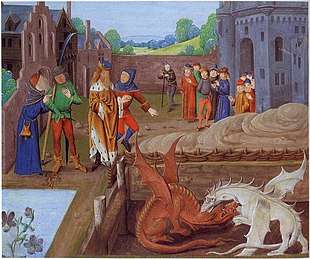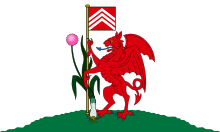Welsh Dragon
The Welsh Dragon (Welsh: Y Ddraig Goch, meaning the red dragon, pronounced [ə ˈðraiɡ ˈɡoːχ]) is a heraldic symbol that appears on the national flag of Wales. The oldest recorded use of the dragon to symbolise Wales is in the Historia Brittonum, written around AD 829, but it is popularly supposed to have been the battle standard of King Arthur and other ancient Celtic leaders. Its association with these leaders, along with other evidence from archaeology, literature, and documentary history, led many to suppose that it evolved from an earlier Romano-British national symbol.[1] During the reigns of the Tudor monarchs, the red dragon was used as a supporter in the English Crown's coat of arms.[2] The red dragon is often seen as symbolising all things Welsh, and is used by many public and private institutions. These include the Welsh Government, Visit Wales, and numerous local authorities including Blaenau Gwent, Cardiff, Carmarthenshire, Rhondda Cynon Taf, Swansea, and sports bodies, including the Sport Wales National Centre, the Football Association of Wales, Wrexham A.F.C., Newport Gwent Dragons, and London Welsh RFC, while the "dragon's tongue" (Tafod y Ddraig) is the symbol of the Welsh Language Society. The Welsh Dragon is also one of The Queen's Beasts.
.svg.png)
History
Mabinogion
In the Mabinogion story Lludd and Llefelys, the red dragon fights with an invading White Dragon. His pained shrieks cause women to miscarry, animals to perish and plants to become barren. Lludd, king of Britain, goes to his wise brother Llefelys in France. Llefelys tells him to dig a pit in the centre of Britain, fill it with mead, and cover it with cloth. Lludd does this, and the dragons drink the mead and fall asleep. Lludd imprisons them, still wrapped in their cloth, in Dinas Emrys in Snowdonia (Welsh: Eryri).
Historia Brittonum

The tale is taken up in the Historia Brittonum. The dragons remain at Dinas Emrys for centuries until King Vortigern tries to build a castle there. Every night the castle walls and foundations are demolished by unseen forces. Vortigern consults his advisers, who tell him to find a boy with no natural father, and sacrifice him. Vortigern finds such a boy (who is later, in some tellings, to become Merlin) who is supposed to be the wisest wizard ever to live. On hearing that he is to be put to death to end the demolition of the walls, the boy is dismissive of the advice, and tells the king about the two dragons. Vortigern excavates the hill, freeing the dragons. They continue their fight and the red dragon finally defeats the white dragon. The boy tells Vortigern that the white dragon symbolises the Saxons and that the red dragon symbolises the people of Vortigern. If Vortigern is accepted to have lived in the 5th century, then these people are the British whom the Saxons failed to subdue and who became the Welsh.
The same story is repeated in Geoffrey of Monmouth's History of the Kings of Britain, where the red dragon is also a prophecy of the coming of King Arthur. Note that Arthur's father was named Uther Pendragon ('Pendragon': 'Pen' (Head) and 'Dragon', being translated by Geoffrey as "dragon's head").
Owain Glyndŵr

Owain Glyndŵr's banner was known as Y Ddraig Aur or 'The Golden Dragon'. It was famously raised over Caernarfon during the Battle of Tuthill in 1401 against the English. The flag has ancient origins; Glyndŵr chose to fly the standard of a golden dragon on a white background, the traditional standard that, supposedly, Uther Pendragon had flown when the first Celtic Britons had fought the Saxons to a standstill almost 1,000 years before, which had been passed down to his son king Arthur.[3][4][5]
Henry VII
Henry Tudor flew the red dragon of Cadwaladr ap Cadwallon as his banner, overlaid on a green and white field representing the Tudor House, when he marched through Wales on his way to Bosworth Field. After the battle the flag was carried in state to St Paul's Cathedral to be blessed.
.svg.png) Standard of Henry Tudor used at the Battle of Bosworth Field
Standard of Henry Tudor used at the Battle of Bosworth Field.svg.png) Coat of arms of Henry VII
Coat of arms of Henry VII
Royal Badge
.svg.png)
In 1953, the red dragon badge of Henry VII was given an augmentation of honour. The augmented badge is blazoned: Within a circular riband Argent fimbriated Or bearing the motto Y DDRAIG GOCH DDYRY CYCHWYN ["the red dragon inspires action"], in letters Vert, and ensigned with a representation of the Crown proper, an escutcheon per fesse Argent and Vert and thereon the Red Dragon passant.[6] Winston Churchill, the then prime minister, despised the badge's design, as is revealed in the following Cabinet minute from 1953:
P.M. [Churchill]
Odious design expressing nothing. but spite, malice, ill-will and monstrosity.
Words (Red Dragon takes the lead) are untrue and unduly flattering to Bevan.Ll.G. [Gwilym Lloyd George]
Wd. rather be on R[oyal] Arms. This (dating from Henry VII) will be something.
We get no recognition in Union – badge or flags.[7]
In 1956, this badge was added to the arms of the Welsh capital city Cardiff by placing it on collars around the necks of the two supporters of the shield.[8] The badge was the basis of a flag of Wales[9] in which it was placed on a background divided horizontally with the top half white and bottom half green. In 1959, Government use of this flag was dropped in favour of the current flag[10][11] at the urging of the Gorsedd of Bards.[12]
The badge is currently used by the Wales Office[13] and is printed on Statutory Instruments made by the National Assembly for Wales.[14] The badge was previously used in the corporate logo of the Assembly until the "dynamic dragon" logo was adopted.[15]
There is a further badge for Wales, belonging to the Princes of Wales since 1901, of the red dragon on a mount but with a label of three points Argent about the shoulder to difference it from the monarch's badge. The badge became a part of the Coat of arms of the Prince of Wales by Royal Warrant.[16] (A similar label of three points is used in his arms, crest and supporters for the same reason.)
This Royal badge was supplanted by a new official Royal badge in 2008, which eliminated the red dragon altogether.
Gallery
 Coat of arms of the Prince of Wales with their red dragon badge
Coat of arms of the Prince of Wales with their red dragon badge The Welsh Dragon motif of Felinfoel Brewery.
The Welsh Dragon motif of Felinfoel Brewery.- The Welsh Dragon on a trig point at Twyn y Gaer hill fort, Mynydd Illtud.
 The Welsh Dragon as one of The Queen's Beasts.
The Welsh Dragon as one of The Queen's Beasts. Flag of Cardiff.
Flag of Cardiff.- A statue of the Welsh Dragon at Capel Moriah.
 Red Dragon sculpture, Welsh Memorial Park, Ypres.
Red Dragon sculpture, Welsh Memorial Park, Ypres.
References
- Davis, Dai. "Y Ddraig Goch – The Red Dragon". welshflag.org. Archived from the original on 9 August 2012.
- See example of dragon supporter Elizabethan Heraldry; "Heralds and Heraldry in Elizabethen England"; accessed 6 September 2010
- Hackett, Martin (15 July 2014). "Lost Battlefields of Wales". Amberley Publishing – via Google Books.
- Davies, John (25 January 2007). "A History of Wales". Penguin Adult – via Google Books.
- Breverton, Terry (15 May 2009). "Owain Glyndwr: The Story of the Last Prince of Wales". Amberley Publishing – via Google Books.
- "The Gazette – Official Public Record". gazettes-online.co.uk.
- "Highlights of new Freedom of Information releases in August 2007 > The Cabinet Secretaries' Notebooks (CAB 195/11) > Arms for Wales". The National Archives (United Kingdom). Archived from the original on 3 November 2007.
- Hartemink, R. International Civic Arms
- "Wales: History of Welsh Flags". flagspot.net.
- Barraclough, EMC. Flags of the World, 1965.
- "WELSH FLAG (Hansard, 23 February 1959)". hansard.millbanksystems.com.
- Lofmark, C. A History of the Red Dragon
- "Office of the Secretary of State for Wales – GOV.UK". www.walesoffice.gov.uk.
- "Welsh Statutory Instruments – Town and Country Planning, Wales" (PDF). opsi.gov.uk.
- "BBC NI – Learning – A State Apart – Intergovernmental Relations – Overview". www.bbc.co.uk.
- "The Gazette – Official Public Record". gazettes-online.co.uk.
Further reading
- Jobbins, Siôn T. (2016), The Red Dragon: The story of the Welsh flag, Tal-y-bont: Y LolfaCS1 maint: ref=harv (link)
- Lofmark, Carl (1995), A History of the Red Dragon, Llanrwst: Gwasg Carreg Gwalch, ISBN 0-86381-317-8
.svg.png)